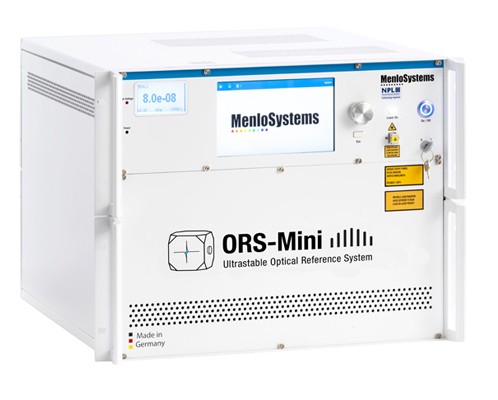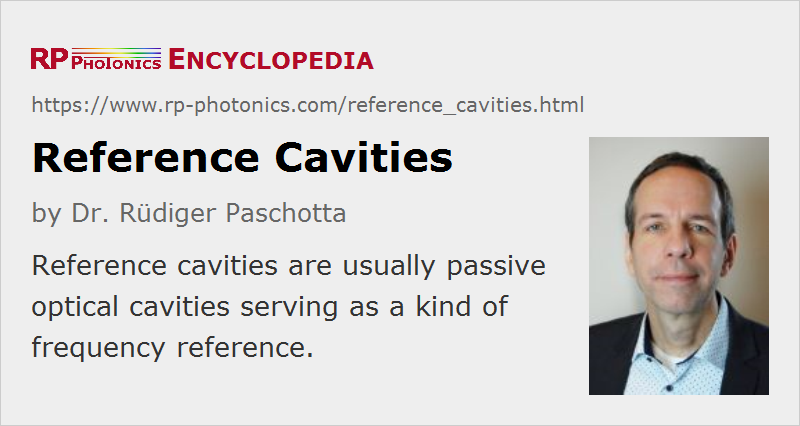Reference Cavities
Definition: optical cavities serving as a kind of frequency reference
More general term: optical resonators
German: Referenzresonatoren
Categories:  optical resonators,
optical resonators,  optical metrology
optical metrology
Author: Dr. Rüdiger Paschotta
Cite the article using its DOI: https://doi.org/10.61835/gwx
Get citation code: Endnote (RIS) BibTex plain textHTML
A reference cavity is a passive optical resonator (resonant cavity) which is used as a kind of fly-wheel oscillator (short-term frequency reference) in an optical frequency standard. The optical frequency of a single-frequency laser (or of a single spectral line of the output of a mode-locked laser) can be stabilized to the frequency of a resonance of the reference cavity, effectively transferring the higher frequency stability of the cavity to the laser. Such stabilization (frequency locking) can be achieved e.g. with an electronic feedback system based on the Pound–Drever–Hall method or the Hänsch–Couillaud method.
Note that the linewidth of a laser oscillator which is stabilized to a reference cavity can be far below the resonator bandwidth, except if the latter is already very small. Therefore, the laser's Q factor may be higher than that of the reference cavity.
Achieving High Frequency Stability
Compared with a laser resonator, a passive reference cavity can be significantly more stable, as it does not have the disturbing influences introduced by a laser gain medium. Also, it can have a very high finesse and Q factor, as the round-trip power losses can be minimized; that leads to a small resonator bandwidth, so that the resonance frequencies can be precisely determined. Further measures can be used to achieve extraordinarily high stability:
- using a rugged construction for the cavity setup, possibly with vibration-absorbing damping elements
- using a spacer material (fixing the spacing of the cavity mirrors) which has a low thermal expansion coefficient, e.g. Invar steel, Zerodur glass or ULE (ultra-low expansion) glass
- isolating the cavity from thermal influences, e.g. by placing it within a temperature-stabilized housing
- placing the cavity in an evacuated chamber, thus removing various influences introduced by the air
- limiting the circulating optical power level, and stabilization of the circulating power, to eliminate or stabilize heating effects
With intense efforts, as undertaken in various frequency metrology laboratories, a reference cavity can be so stable that a laser stabilized to it can have a short-term linewidth below 1 Hz.
More to Learn
Encyclopedia articles:
Suppliers
The RP Photonics Buyer's Guide contains two suppliers for reference cavities. Among them:


Menlo Systems
Menlo Systems provides full solutions for optical frequency standards based on ultrastable lasers as well as components for users that prefer to build their own system. Applications are in today's most demanding measurements in metrology and precision measurements when state-of-the art radio-frequency standards come to their limits.
Bibliography
| [1] | C. Salomon et al., “Laser stabilization at the millihertz level”, J. Opt. Soc. Am. B 5 (8), 1576 (1988); https://doi.org/10.1364/JOSAB.5.001576 |
| [2] | J. Dirscherl et al., “A dye laser spectrometer for high resolution spectroscopy”, Opt. Commun. 91, 131 (1992); https://doi.org/10.1016/0030-4018(92)90114-7 |
| [3] | T. Day et al., “Sub-hertz relative frequency stabilization of two-diode laser-pumped Nd:YAG lasers locked to a Fabry–Perot interferometer”, IEEE J. Quantum Electron. 28 (4), 1106 (1992); https://doi.org/10.1109/3.135234 |
| [4] | S. Seel et al., “Cryogenic optical resonators: a new tool for laser frequency stabilization at the 1 Hz level”, Phys. Rev. Lett. 78 (25), 4741 (1997); https://doi.org/10.1103/PhysRevLett.78.4741 |
| [5] | B. C. Young et al., “Visible lasers with subhertz linewidth”, Phys. Rev. Lett. 82 (19), 3799 (1999); https://doi.org/10.1103/PhysRevLett.82.3799 |
| [6] | T. Liu et al., “Characterization of the absolute frequency stability of an individual reference cavity”, Opt. Lett. 34 (2), 190 (2009); https://doi.org/10.1364/OL.34.000190 |
| [7] | J. Millo et al., “Ultrastable lasers based on vibration insensitive cavities”, Phys. Rev. A 79 (5), 053829 (2009); https://doi.org/10.1103/PhysRevA.79.053829 |
Questions and Comments from Users
Here you can submit questions and comments. As far as they get accepted by the author, they will appear above this paragraph together with the author’s answer. The author will decide on acceptance based on certain criteria. Essentially, the issue must be of sufficiently broad interest.
Please do not enter personal data here; we would otherwise delete it soon. (See also our privacy declaration.) If you wish to receive personal feedback or consultancy from the author, please contact him, e.g. via e-mail.
By submitting the information, you give your consent to the potential publication of your inputs on our website according to our rules. (If you later retract your consent, we will delete those inputs.) As your inputs are first reviewed by the author, they may be published with some delay.



Connect and share this with your network:
Follow our specific LinkedIn pages for more insights and updates: